Cisco Certification Exam Prep Materials
Cisco CCNA Exam Prep Material Download
Cisco CCT Exam Prep Material Download
- Cisco 010-151 Dumps PDF
- Cisco 100-490 Dumps PDF
- Cisco 100-890 Dumps PDF
- Tips: Beginning February 10, the CCT Certification 500-150 FLDTEC v1.0 exam will replace the 100-490, 010-151, and 100-890 exams.
Cisco CyberOps Exam Prep Material Download
Cisco DevNet Exam Prep Material Download
Cisco CCNP Exam Prep Material Download
- Cisco 300-410 Dumps PDF
- Cisco 300-415 Dumps PDF
- Cisco 300-420 Dumps PDF
- Cisco 300-425 Dumps PDF
- Cisco 300-430 Dumps PDF
- Cisco 300-435 Dumps PDF
- Cisco 300-440 Dumps PDF
- Cisco 300-510 Dumps PDF
- Cisco 300-515 Dumps PDF
- Cisco 300-535 Dumps PDF
- Cisco 300-610 Dumps PDF
- Cisco 300-615 Dumps PDF
- Cisco 300-620 Dumps PDF
- Cisco 300-630 Dumps PDF
- Cisco 300-635 Dumps PDF
- Cisco 300-710 Dumps PDF
- Cisco 300-715 Dumps PDF
- Cisco 300-720 Dumps PDF
- Cisco 300-725 Dumps PDF
- Cisco 300-730 Dumps PDF
- Cisco 300-735 Dumps PDF
- Cisco 300-810 Dumps PDF
- Cisco 300-815 Dumps PDF
- Cisco 300-820 Dumps PDF
- Cisco 300-835 Dumps PDF
Cisco CCIE Exam Prep Material Download
- Cisco 350-401 Dumps PDF
- Cisco 350-501 Dumps PDF
- Cisco 350-601 Dumps PDF
- Cisco 350-701 Dumps PDF
- Cisco 350-801 Dumps PDF
Cisco CCDE Exam Prep Material Download
Cisco Other Exam Prep Material Download
- Cisco 500-052 Dumps PDF
- Cisco 500-210 Dumps PDF
- Cisco 500-220 Dumps PDF
- Cisco 500-420 Dumps PDF
- Cisco 500-442 Dumps PDF
- Cisco 500-444 Dumps PDF
- Cisco 500-470 Dumps PDF
- Cisco 500-490 Dumps PDF
- Cisco 500-560 Dumps PDF
- Cisco 500-710 Dumps PDF
- Cisco 700-150 Dumps PDF
- Cisco 700-750 Dumps PDF
- Cisco 700-760 Dumps PDF
- Cisco 700-765 Dumps PDF
- Cisco 700-805 Dumps PDF
- Cisco 700-821 Dumps PDF
- Cisco 700-826 Dumps PDF
- Cisco 700-846 Dumps PDF
- Cisco 700-905 Dumps PDF
- Cisco 820-605 Dumps PDF
Fortinet Exam Dumps
fortinet nse4_fgt-6.4 dumps (pdf + vce)
fortinet nse4_fgt-6.2 dumps (pdf + vce)
fortinet nse5_faz-6.4 dumps (pdf + vce)
fortinet nse5_faz-6.2 dumps (pdf + vce)
fortinet nse5_fct-6.2 dumps (pdf + vce)
fortinet nse5_fmg-6.4 dumps (pdf + vce)
fortinet nse5_fmg-6.2 dumps (pdf + vce)
fortinet nse6_fml-6.2 dumps (pdf + vce)
fortinet nse6_fnc-8.5 dumps (pdf + vce)
fortinet nse7_efw-6.4 dumps (pdf + vce)
fortinet nse7_efw-6.2 dumps (pdf + vce)
fortinet nse7_sac-6.2 dumps (pdf + vce)
fortinet nse7_sdw-6.4 dumps (pdf + vce)
fortinet nse8_811 dumps (pdf + vce)
Pass4itsure share these resources with you. Both VCE and PDF dumps contain the latest Microsoft DP-300 exam questions, which will ensure your DP-300 exam 100% passed! You can get DP-300 VCE dumps and DP-300 PDF dumps from Pass4itsure. Please get the latest Pass4itsure DP-300 dumps here: https://www.pass4itsure.com/dp-300.html (56 QA Dumps).
So light up your lamp of success by visiting Here: Get the latest Microsoft DP-300 exam pdf [Updated] https://drive.google.com/file/d/11rHIja3gXnnyf0vO66nEAfu71lVk2nmq/view?usp=sharing
Microsoft DP-300 exam video
Microsoft DP-300 exam practice questions and answers 1-13
Microsoft DP-300 exam pdf free download [from drive]
Pass4itsure DP-300 exam passing guarantee 100% and 24/7 customer care service:
Pass4itsure discount code 2020
Microsoft Role-based DP-300 exam practice questions and answers 1-13
QUESTION 1
You have two Azure SQL Database servers named Server1 and Server2. Each server contains an Azure SQL database
named Database1.
You need to restore Database1 from Server1 to Server2. The solution must replace the existing Database1 on Server2.
Solution: You run the Remove-AzSqlDatabase PowerShell cmdlet for Database1 on Server2. You run the RestoreAzSqlDatabase PowerShell cmdlet for Database1 on Server2.
Does this meet the goal?
A. Yes
B. No
Correct Answer: B
Instead restore Database1 from Server1 to the Server2 by using the RESTORE Transact-SQL command and the
REPLACE option.
Note: REPLACE should be used rarely and only after careful consideration. Restore normally prevents accidentally
overwriting a database with a different database. If the database specified in a RESTORE statement already exists on
the current server and the specified database family GUID differs from the database family GUID recorded in the
backup set, the database is not restored. This is an important safeguard.
Reference: https://docs.microsoft.com/en-us/sql/t-sql/statements/restore-statements-transact-sql
QUESTION 2
HOTSPOT
You have an Azure SQL database named db1.
You need to retrieve the resource usage of db1 from the last week.
How should you complete the statement? To answer, select the appropriate options in the answer area.
NOTE: Each correct selection is worth one point.
Hot Area:
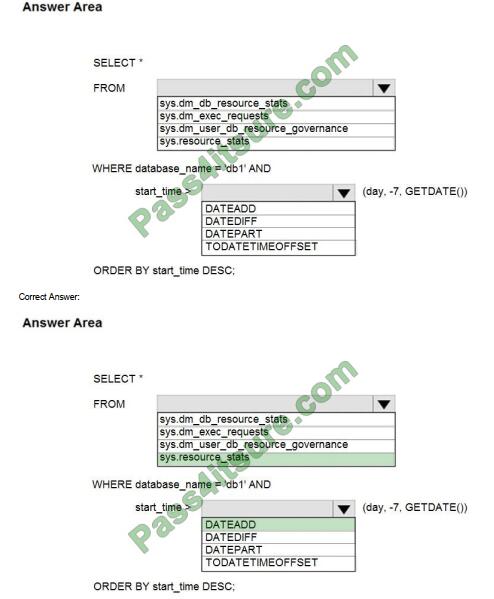
Box 1: sys.resource_stats
sys.resource_stats returns CPU usage and storage data for an Azure SQL Database. It has database_name and
start_time columns.
Box 2: DateAdd
The following example returns all databases that are averaging at least 80% of compute utilization over the last one
week.
DECLARE @s datetime;
DECLARE @e datetime;
SET @s= DateAdd(d,-7,GetUTCDate());
SET @e= GETUTCDATE();
SELECT database_name, AVG(avg_cpu_percent) AS Average_Compute_Utilization FROM sys.resource_stats
WHERE start_time BETWEEN @s AND @e GROUP BY database_name HAVING AVG(avg_cpu_percent) >= 80
Incorrect Answers: sys.dm_exec_requests: sys.dm_exec_requests returns information about each request that is
executing in SQL Server. It does not have a column named database_name.
sys.dm_db_resource_stats:
sys.dm_db_resource_stats does not have any start_time column.
Note: sys.dm_db_resource_stats returns CPU, I/O, and memory consumption for an Azure SQL Database database.
One row exists for every 15 seconds, even if there is no activity in the database. Historical data is maintained for
approximately one hour.
Sys.dm_user_db_resource_governance returns actual configuration and capacity settings used by resource governance
mechanisms in the current database or elastic pool. It does not have any start_time column.
Reference:
https://docs.microsoft.com/en-us/sql/relational-databases/system-catalog-views/sys-resource-stats-azure-sql-database
QUESTION 3
You need to recommend an availability strategy for an Azure SQL database. The strategy must meet the following
requirements:
Support failovers that do not require client applications to change their connection strings.
Replicate the database to a secondary Azure region.
Support failover to the secondary region.
What should you include in the recommendation?
A. failover groups
B. transactional replication
C. Availability Zones
D. geo-replication
Correct Answer: D
Active geo-replication is an Azure SQL Database feature that allows you to create readable secondary databases of
individual databases on a server in the same or different data center (region). Incorrect Answers:
C: Availability Zones are unique physical locations within a region. Each zone is made up of one or more datacenters
equipped with independent power, cooling, and networking.
Reference: https://docs.microsoft.com/en-us/azure/azure-sql/database/active-geo-replication-overview
QUESTION 4
HOTSPOT
You have an Azure SQL database that contains a table named Customer. Customer has the columns shown in the
following table.

You plan to implement a dynamic data mask for the Customer_Phone column. The mask must meet the following
requirements:
The first six numerals of each customer\\’s phone number must be masked. The last four digits of each customer\\’s
phone number must be visible. Hyphens must be preserved and displayed.
How should you configure the dynamic data mask? To answer, select the appropriate options in the answer area.
Hot Area:
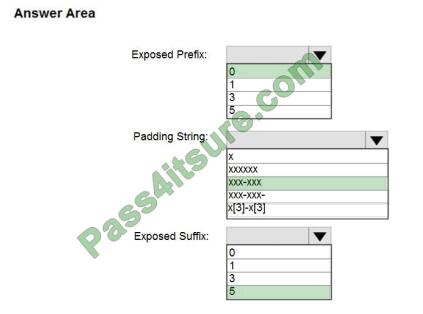
Correct Answer:
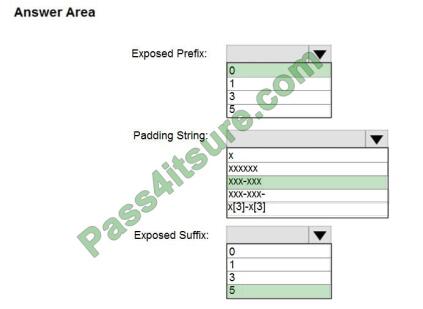
Box 1: 0 Custom String : Masking method that exposes the first and last letters and adds a custom padding string in the
middle. prefix,[padding],suffix Box 2: xxx-xxx
Box 3: 5 Reference: https://docs.microsoft.com/en-us/sql/relational-databases/security/dynamic-data-masking
QUESTION 5
You have 10 Azure virtual machines that have SQL Server installed.
You need to implement a backup strategy to ensure that you can restore specific databases to other SQL Server
instances. The solution must provide centralized management of the backups.
What should you include in the backup strategy?
A. Automated Backup in the SQL virtual machine settings
B. Azure Backup
C. Azure Site Recovery
D. SQL Server Agent jobs
Correct Answer: B
Azure Backup provides an Enterprise class backup capability for SQL Server on Azure VMs. All backups are stored and
managed in a Recovery Services vault. There are several advantages that this solution provides, especially for
Enterprises.
Reference: https://docs.microsoft.com/en-us/azure/azure-sql/virtual-machines/windows/backup-restore#azbackup
QUESTION 6
HOTSPOT
You have SQL Server on an Azure virtual machine.
You review the query plan shown in the following exhibit.
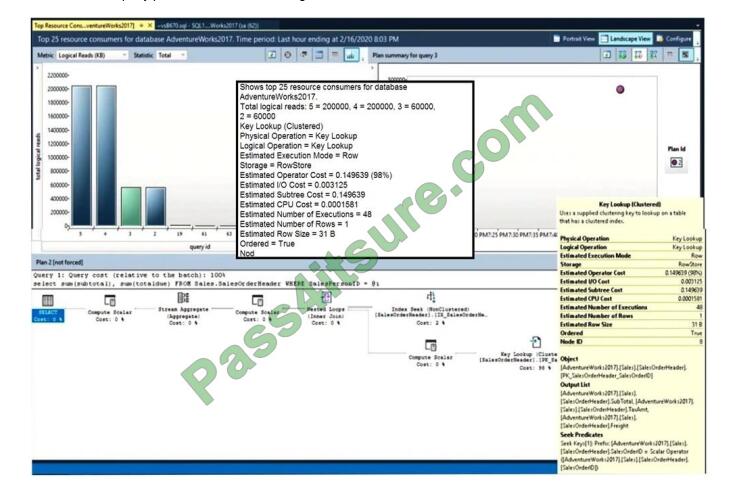
For each of the following statements, select yes if the statement is true. Otherwise, select no. NOTE: Each correct
selection is worth one point.
Hot Area:
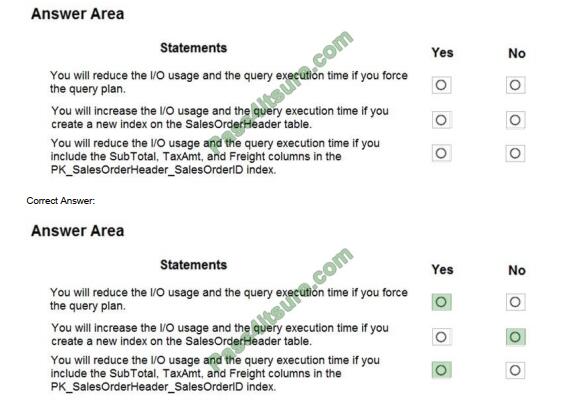
QUESTION 7
A data engineer creates a table to store employee information for a new application. All employee names are in the US
English alphabet. All addresses are locations in the United States. The data engineer uses the following statement to
create the table.
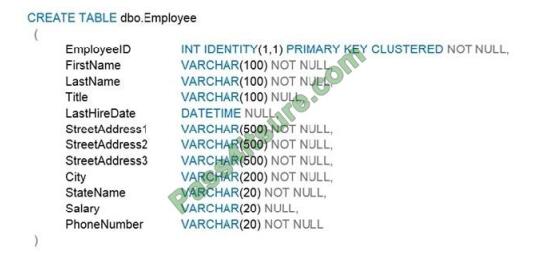
You need to recommend changes to the data types to reduce storage and improve performance. Which two actions
should you recommend? Each correct answer presents part of the solution.
NOTE: Each correct selection is worth one point.
A. Change Salary to the money data type.
B. Change PhoneNumber to the float data type.
C. Change LastHireDate to the datetime2(7) data type.
D. Change PhoneNumber to the bigint data type.
E. Change LastHireDate to the date data type.
Correct Answer: AE
QUESTION 8
HOTSPOT
You have a Microsoft SQL Server database named DB1 that contains a table named Table1.
The database role membership for a user named User1 is shown in the following exhibit.
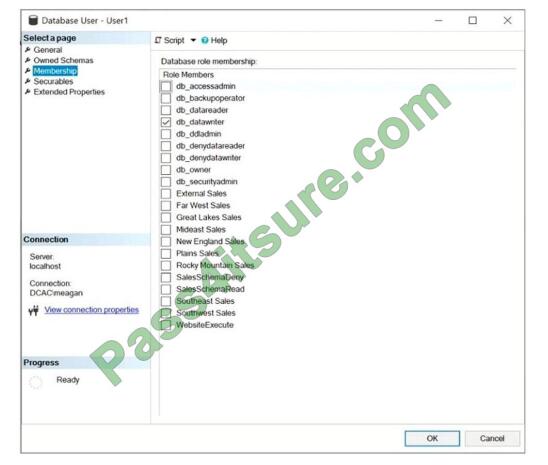
Use the drop-down menus to select the answer choice that completes each statement based on the information
presented in the graphic.
NOTE: Each correct selection is worth one point.
Hot Area:
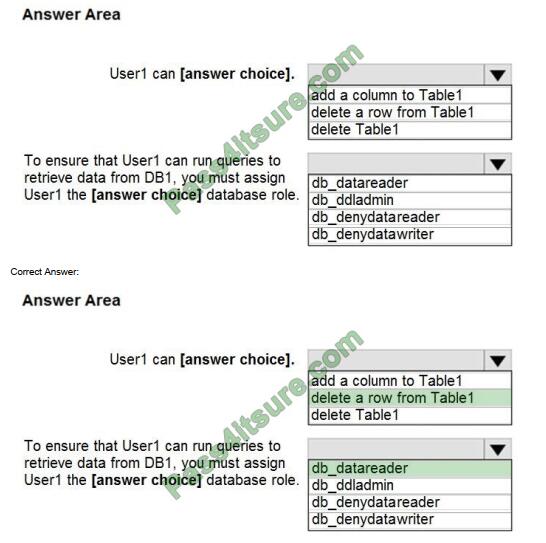
Box 1: delete a row from Table1
Members of the db_datawriter fixed database role can add, delete, or change data in all user tables.
Box 2: db_datareader
Members of the db_datareader fixed database role can read all data from all user tables.
Reference:
https://docs.microsoft.com/en-us/sql/relational-databases/security/authentication-access/database-level-roles
QUESTION 9
DRAG DROP
You have a resource group named App1Dev that contains an Azure SQL Database server named DevServer1.
DevServer1 contains an Azure SQL database named DB1. The schema and permissions for DB1 are saved in a
Microsoft SQL
Server Data Tools (SSDT) database project.
You need to populate a new resource group named App1Test with the DB1 database and an Azure SQL Server named
TestServer1. The resources in App1Test must have the same configurations as the resources in App1Dev.
Which four actions should you perform in sequence? To answer, move the appropriate actions from the list of actions to
the answer area and arrange them in the correct order.
Select and Place:
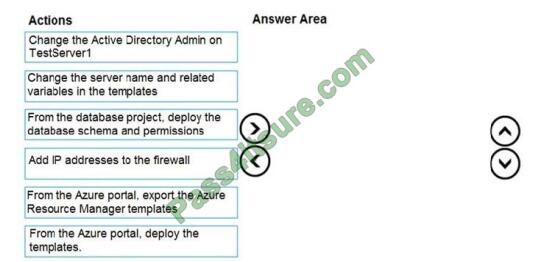
Correct Answer:
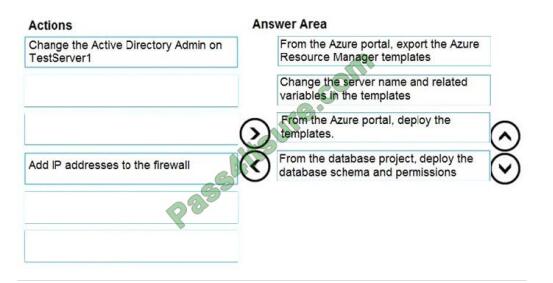
QUESTION 10
You are building a database backup solution for a SQL Server database hosted on an Azure virtual machine.
In the event of an Azure regional outage, you need to be able to restore the database backups. The solution must
minimize costs.
Which type of storage accounts should you use for the backups?
A. locally-redundant storage (LRS)
B. read-access geo-redundant storage (RA-GRS)
C. zone-redundant storage (ZRS)
D. geo-redundant storage
Correct Answer: B
Geo-redundant storage (with GRS or GZRS) replicates your data to another physical location in the secondary region to
protect against regional outages. However, that data is available to be read only if the customer or Microsoft initiates a
failover from the primary to secondary region. When you enable read access to the secondary region, your data is
available to be read if the primary region becomes unavailable. For read access to the secondary region, enable readaccess geo-redundant storage (RA-GRS) or read-access geo-zone-redundant storage (RA-GZRS).
Incorrect Answers:
A: Locally redundant storage (LRS) copies your data synchronously three times within a single physical location in the
primary region. LRS is the least expensive replication option, but is not recommended for applications requiring high
availability.
C: Zone-redundant storage (ZRS) copies your data synchronously across three Azure availability zones in the primary
region.
D: Geo-redundant storage (with GRS or GZRS) replicates your data to another physical location in the secondary region
to protect against regional outages. However, that data is available to be read only if the customer or Microsoft initiates
a failover from the primary to secondary region.
Reference: https://docs.microsoft.com/en-us/azure/storage/common/storage-redundancy
QUESTION 11
You have an Azure SQL database.
You identify a long running query.
You need to identify which operation in the query is causing the performance issue.
What should you use to display the query execution plan in Microsoft SQL Server Management Studio (SSMS)?
A. Live Query Statistics
B. an estimated execution plan
C. an actual execution plan
D. Client Statistics
Correct Answer: C
To include an execution plan for a query during execution
1.
On the SQL Server Management Studio toolbar, click Database Engine Query. You can also open an existing query
and display the estimated execution plan by clicking the Open File toolbar button and locating the existing query.
2.
Enter the query for which you would like to display the actual execution plan.
3.
On the Query menu, click Include Actual Execution Plan or click the Include Actual Execution Plan toolbar button.

Note: Actual execution plans are generated after the Transact-SQL queries or batches execute. Because of this, an
actual execution plan contains runtime information, such as actual resource usage metrics and runtime warnings (if
any). The execution plan that is generated displays the actual query execution plan that the SQL Server Database
Engine used to execute the queries.
Reference: https://docs.microsoft.com/en-us/sql/relational-databases/performance/display-an-actual-execution-plan
QUESTION 12
You have an Azure SQL database named Sales.
You need to implement disaster recovery for Sales to meet the following requirements:
During normal operations, provide at least two readable copies of Sales.
Ensure that Sales remains available if a datacenter fails.
Solution: You deploy an Azure SQL database that uses the Business Critical service tier and Availability Zones.
Does this meet the goal?
A. Yes
B. No
Correct Answer: A
Premium and Business Critical service tiers leverage the Premium availability model, which integrates compute
resources (sqlservr.exe process) and storage (locally attached SSD) on a single node. High availability is achieved by
replicating both compute and storage to additional nodes creating a three to four-node cluster.
By default, the cluster of nodes for the premium availability model is created in the same datacenter. With the
introduction of Azure Availability Zones, SQL Database can place different replicas of the Business Critical database to
different availability zones in the same region. To eliminate a single point of failure, the control ring is also duplicated
across multiple zones as three gateway rings (GW).
Reference: https://docs.microsoft.com/en-us/azure/azure-sql/database/high-availability-sla
QUESTION 13
You have SQL Server on an Azure virtual machine that contains a database named DB1.
You have an application that queries DB1 to generate a sales report.
You need to see the parameter values from the last time the query was executed.
Which two actions should you perform? Each correct answer presents part of the solution.
NOTE: Each correct selection is worth one point.
A. Enable Last_Query_Plan_Stats in the master database
B. Enable Lightweight_Query_Profiling in DB1
C. Enable Last_Query_Plan_Stats in DB1
D. Enable Lightweight_Query_Profiling in the master database
E. Enable PARAMETER_SNIFFING in DB1
Correct Answer: AC
Last_Query_Plan_Stats allows you to enable or disable collection of the last query plan statistics (equivalent to an
actual execution plan) in sys.dm_exec_query_plan_stats.
Lightweight profiling can be disabled at the database level using the LIGHTWEIGHT_QUERY_PROFILING database
scoped configuration: ALTER DATABASE SCOPED CONFIGURATION SET LIGHTWEIGHT_QUERY_PROFILING =
OFF;.
Incorrect Answers:
E: Parameter sensitivity, also known as “parameter sniffing”, refers to a process whereby SQL Server “sniffs” the
current parameter values during compilation or recompilation, and passes it along to the Query Optimizer so that they
can be used to generate potentially more efficient query execution plans.
Parameter values are sniffed during compilation or recompilation for the following types of batches: Stored procedures
Queries submitted via sp_executesql Prepared queries
Reference: https://docs.microsoft.com/en-us/sql/relational-databases/performance/query-profiling-infrastructure
Microsoft DP-300 exam pdf free download [from drive]
[pdf] DP-300 exam pdf free download https://drive.google.com/file/d/11rHIja3gXnnyf0vO66nEAfu71lVk2nmq/view?usp=sharing

Pass4itsure DP-300 exam passing guarantee 100% and 24/7 customer care service:
When preparing questions for the Microsoft DP-300 exam, there are always fears that the DP-300 exam will fail. However, with Pass4itsure Microsoft DP-300 training materials, you can get a 100% pass guarantee. With Microsoft DP-300 dumps pdf questions, you can also get 24/7 customer service and free 365-day updates for all Microsoft exams.
Pass4itsure discount code 2020

Latest discount code “2020PASS” – Pass4itsure.
P.S.
Want to get free DP-300 exam dumps? This is right, Alnaba have collected the latest DP-300 exam questions, there is a PDF or video format, you can download for. Get more of the most reliable Microsoft DP-300 exam dumps materials. please visit https://www.pass4itsure.com/dp-300.html Q&As: 56. Study hard and practice a lot.
Related
Discover more from Exampass: Collection of Cisco (CCNA, CCNP, Meraki Solutions Specialist, CCDP...) exam questions and answers from Pass4itsure
Subscribe to get the latest posts sent to your email.
Written by Ralph K. Merritt
We are here to help you study for Cisco certification exams. We know that the Cisco series (CCNP, CCDE, CCIE, CCNA, DevNet, Special and other certification exams are becoming more and more popular, and many people need them. In this era full of challenges and opportunities, we are committed to providing candidates with the most comprehensive and comprehensive Accurate exam preparation resources help them successfully pass the exam and realize their career dreams. The Exampass blog we established is based on the Pass4itsure Cisco exam dump platform and is dedicated to collecting the latest exam resources and conducting detailed classification. We know that the most troublesome thing for candidates during the preparation process is often the massive amount of learning materials and information screening. Therefore, we have prepared the most valuable preparation materials for candidates to help them prepare more efficiently. With our rich experience and deep accumulation in Cisco certification, we provide you with the latest PDF information and the latest exam questions. These materials not only include the key points and difficulties of the exam, but are also equipped with detailed analysis and question-answering techniques, allowing candidates to deeply understand the exam content and master how to answer questions. Our ultimate goal is to help you study for various Cisco certification exams, so that you can avoid detours in the preparation process and get twice the result with half the effort. We believe that through our efforts and professional guidance, you will be able to easily cope with exam challenges, achieve excellent results, and achieve both personal and professional improvement. In your future career, you will be more competitive and have broader development space because of your Cisco certification.
Categories
2025 Microsoft Top 20 Certification Materials
- Microsoft Azure Administrator –> az-104 dumps
- Microsoft Azure Fundamentals –> az-900 dumps
- Data Engineering on Microsoft Azure –> dp-203 dumps
- Developing Solutions for Microsoft Azure –> az-204 dumps
- Microsoft Power Platform Developer –> pl-400 dumps
- Designing and Implementing a Microsoft Azure AI Solution –> ai-102 dumps
- Microsoft Power BI Data Analyst –> pl-300 dumps
- Designing and Implementing Microsoft DevOps Solutions –> az-400 dumps
- Microsoft Azure Security Technologies –> az-500 dumps
- Microsoft Cybersecurity Architect –> sc-100 dumps
- Microsoft Dynamics 365 Fundamentals Customer Engagement Apps (CRM) –> mb-910 dumps
- Microsoft Dynamics 365 Fundamentals Finance and Operations Apps (ERP) –> mb-920 dumps
- Microsoft Azure Data Fundamentals –> dp-900 dumps
- Microsoft 365 Fundamentals –> ms-900 dumps
- Microsoft Security Compliance and Identity Fundamentals –> sc-900 dumps
- Microsoft Azure AI Fundamentals –> ai-900 dumps
- Microsoft Dynamics 365: Finance and Operations Apps Solution Architect –> mb-700 dumps
- Microsoft 365 Certified: Enterprise Administrator Expert –> ms-102 dumps
- Microsoft 365 Certified: Collaboration Communications Systems Engineer Associate –> ms-721 dumps
- Endpoint Administrator Associate –> md-102 dumps

